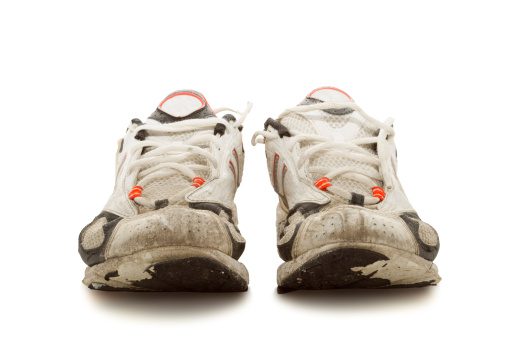Am I wearing worn-out running shoes?

Knowing the lifespan of running shoes can be tricky. Many runners are tempted to push their shoes beyond their due date (Hey, shoes are pricey!), but making sure they aren’t worn out can prevent running injuries like shin splints, runner’s knee and plantar fasciitis.
A general rule of thumb says to replace running shoes every 480 to 800K. That’s a big range though and there are several things that can cause the running shoe an early death.
Consider the surface you run on
Pavement is tough on shoes (so is nasty weather), so if you’re in a city and most of your routes feature long stretches of asphalt, your shoes are going to wear out faster than if you’re running fields. A runner’s body size and weight also factor in. A larger runner is going to put more stress on shoes than the one who is petite. Buying shoes with extra cushioning and appropriate support will help.
Less is less, more is more
Think about the type of shoe you want to be running in. If you’re using a lightweight trainer or racing flat for long distances, it’s not going to last because these types of shoes sacrifice durability for performance. Stability shoes with extra mid-sole cushioning will, of course, be more durable. Also, the material of the outsole matters. EVA foam wears out much quicker than blown rubber. Many lightweight shoes will use minimal amounts of rubber outsole material in order to cut back on weight, but that means that the less resilient EVA will begin to wear more quickly.
Inspect your shoes
Take one of your pairs and look at it from the side. It’s normal to see a few wrinkles from compression. Are the wrinkles close together? Several close together wrinkles indicate a worn out mid-sole. Look at the bottom. If the cushioning feels brittle or the outsole material has worn away, it’s time to get a new pair.
And one of the easiest ways to tell if the shoe is past its due: think about how you’re feeling. If you’re constantly achy when you get back from even an easy run, that can be a sign your shoes are cooked.
Keep track of your Ks
If you don’t already, track your mileage in each pair. Keep a running journal and make sure to note how many Ks you’ve logged with that pair. If you have more than one pair of the same model of shoe in your rotation, number them with a permanent marker. If you run more or less the same distance on each run, you can also mark the inside of the midsole each time your finish.
A new season means new shoes
If you typically run a spring or fall goal race, retire that season’s shoes after your big accomplishment. If they feel like they still have some pop in them (and don’t stink) retire them to your line-up of walking shoes. Buying a shiny new pair of trainers is also a great way to motivate yourself to get back into the swing of things – after you’ve recovered from your goal race, of course.
Running shoes are only for running
To prolong the sneaker’s lifespan, resist the urge to wear them when not running. Make your running shoes special. Only take them out when you’re ready to run.

